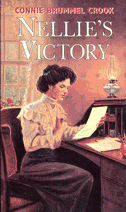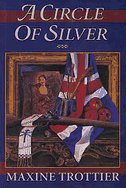Nellie’S Victory

by Connie Brumme
200 pages,
ISBN: 0773674810
A Circle Of Silver

by Maxine Trottier
220 pages,
ISBN: 0773760555
Post Your Opinion | | Children’S Books
by Marnie ParsonsAs a child, I loved historical fiction. I read most of the work of British writer Rosemary Sutcliff, and I devoured novels like Rifles for Waite and Johnny Tremaine. What I don’t recall, however, is reading Canadian historical fiction. A failure of memory or of my reach on library shelves? While I didn’t doubt our history was rich and intense, nor did I stumble across children’s writers who put that into language. As an adult reader of children’s literature, I’m delighted whenever I discover new, fine fiction based on Canadian history.
Maxine Trottier’s A Circle of Silver is a departure from the picture books she’s well-known for, but it retains certain qualities of that work. Connie Brummel Crook’s Nellie’s Victory is the third in her fictionalized biography of Nellie McClung. Trottier’s is the more obviously historical with fictional characters interacting with historical figures (in this case, Pontiac and Trottier’s grandparents “eight generations back”); Crook’s biography takes some of the liberty of fiction to flesh out McClung. While the two writers come at the core of an historical moment or character from different angles and have different aims, their works share a weakness: as much as these writers know about their subjects, as clearly as they want to make those subjects interesting and accessible to children, there’s a distance between writer and reader, between the language employed and the intensity of the lives and events presented.
Crook’s novel covers fifteen years of McClung’s life—from her writing of the short story that would eventually be expanded into her best-selling first novel, to the climax of her long fight to gain suffrage for women in Manitoba. Crook strives for a balanced representation similar to that balance McClung had to cultivate between public and private life: political activism, domestic duty, and writerly solitude. Ample notes point out Crook’s many quotations and paraphrases of McClung’s writing and contemporary newspaper accounts of her speeches and protests. It’s the explanation just before those notes that illuminates my hesitations about the book: “Often, I have changed a quote slightly to make it more readable for today’s students,” Crook writes, identifying not only her extensive use of quotations, but also her didactic purpose.
All literature informs, of course, even when an author hasn’t set out to do so; but when authors adopt instruction as a primary aim, art suffers. That’s the case with Nellie’s Victory. Dialogue is often a vehicle for imparting information. Intimate conversations between husband and wife, for instance, become awkward relations of facts and context, staged and artificial. Stilted conversations affect the development of character and plot. The novel labours under the burden of information.
I appreciate Crook’s dilemma: she’s not writing fiction so she wants to dramatize without distorting or misrepresenting. And while McClung is a fascinating and vibrant person, a non-fiction writer can get only so far inside her without turning her into a construction rather than a re-creation, fabrication rather than fact. Crook’s fictional biography is skewed to instruct. And in that skewing, in that choice to teach children about the importance of Nellie McClung as social activist and feminist, rather than to explore who McClung was, Crook sets a tone that limits the success of her work. Her prose is clear and competent, her structure accessible and logical, but the book lacks vivacity and passion. The narrator speaks down to her audience, not with condescension but with a plodding determination. Nothing in the writing carries the curiosity and enthusiasm that, no doubt, Crook would like to inspire in her reader. Failing to find that in the writing, a reader of any age is unlikely to find it in herself.
Trottier’s story focuses on the fictional John MacNeil who, at the age of thirteen, comes to Canada (with his father) to make maps. Eventually he becomes the king’s official artist in Canada. It’s the 1760s, and John encounters British soldiers, French villagers, Native guides and warriors, a Scottish trapper, the famous chief Pontiac, and Madelaine Roy, a Métis girl who, with her younger brother, Samuel, befriends him. John’s friendship with Madelaine is parallelled by his close relationship with his twin sister, Jane, who remains in England. The correspondence between brother and sister records changes in him, as he becomes absorbed by the landscape of Canada and tries to use his art to bridge a huge cultural divide, and in her, as she matures from imaginative, daydreaming child into settled, soon-to-be-wed woman. Similar changes are wrought in Madelaine over the course of the novel, reminding a reader how alike people in very different cultural contexts may be. Focusing on the important but relatively unfamiliar events leading up to Pontiac’s 1763 rebellion, A Circle of Silver has the makings of a rich and engaging novel. Unfortunately, this potential is not realized.
Most of the complex political tensions of the time are filled in rather than animated. Dramatic episodes are brief; neither their inherent power nor their historical implications are ever fully exploited. Because Trottier has difficulty accommodating her established prose style to the novel form, the novel reads like a sustained deflection, like a series of picture books laced together with gestures towards narrative continuity. I don’t mean to be dismissive; it’s harder to write a good picture book than a good novel. But elaboration of action is very different from compression; the two forms have enormously different needs. Over and over I found myself frustrated by actions insufficiently explored, by conflicts stated briefly rather than developed at length. Almost always I felt I was being told things rather than shown them, and even then not told enough. As well, I have hesitations about Trottier’s language. Her use of dialect for Scottish trapper Wallace Doig is inconsistent and distracting, for instance; but a greater disappointment is the lack of stretch in her language. Trottier’s prose is competent and clean, but rarely beautiful. Perhaps she has forgotten that beautiful writing can be more captivating than plot.
Marnie Parsons lives in St. John’s, Newfoundland.
|